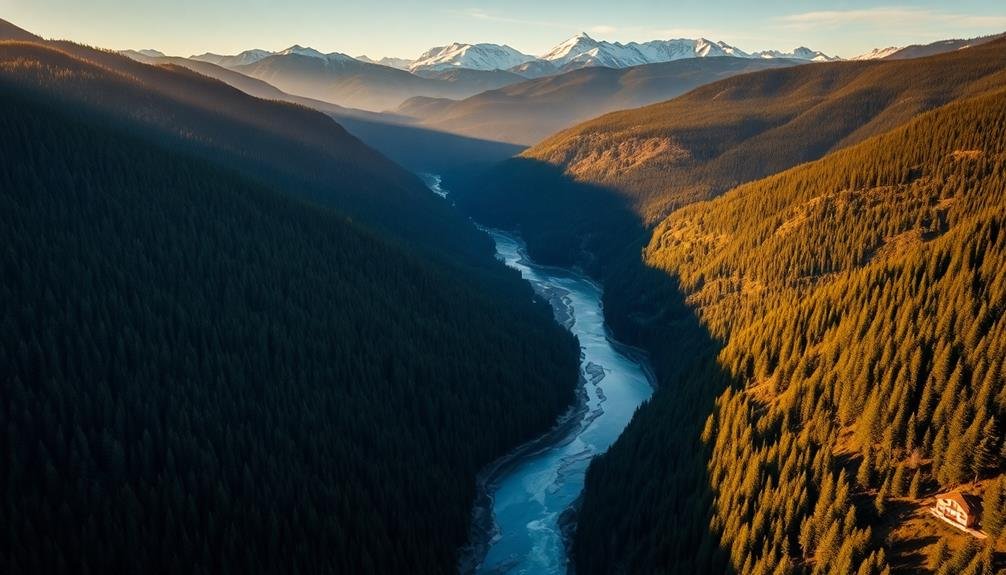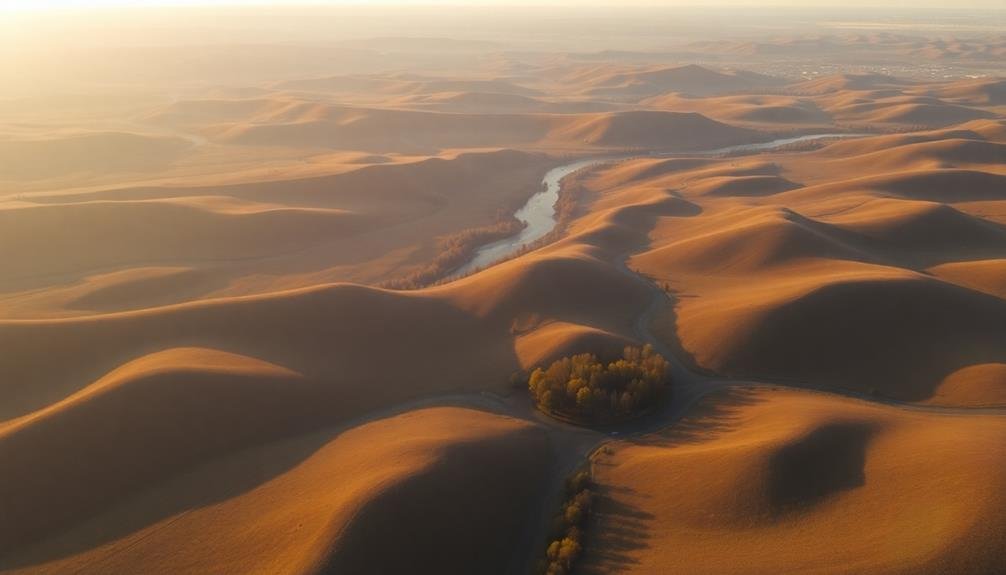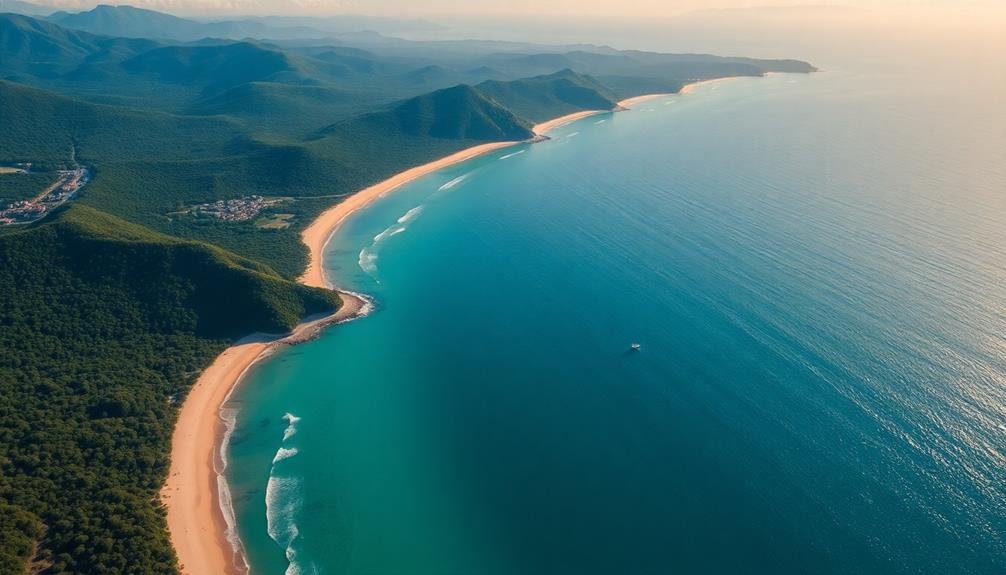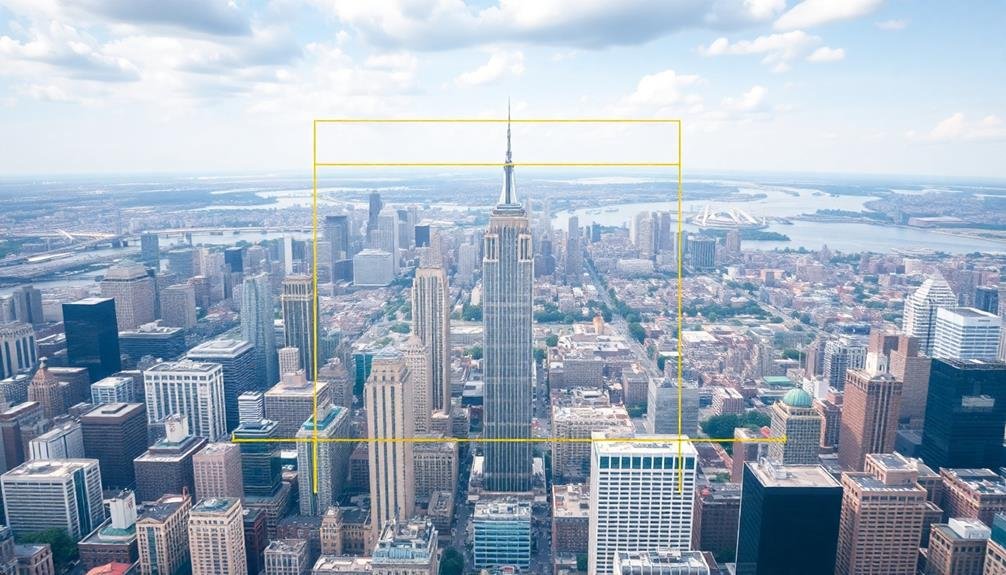To elevate your aerial photography, focus on mastering three key aspect ratios. The classic 4:3 ratio offers versatility and balanced compositions, ideal for landscapes and easy cropping. The widescreen 16:9 perspective adds cinematic flair, capturing more horizontal information and emphasizing leading lines. For breathtaking panoramic views, explore the 3:1 ratio, which excels at showcasing sweeping landscapes and skylines. Each ratio has its strengths, allowing you to adapt to different scenes and creative visions. By understanding these aspect ratios, you'll reveal new possibilities and take your aerial photography to new heights.
Key Takeaways
- 4:3 ratio offers balanced framing for landscapes and versatile compatibility with screens and print formats.
- 16:9 ratio provides a cinematic perspective, emphasizing horizontal elements and leading lines in aerial scenes.
- 3:1 panoramic ratio captures sweeping landscapes, ideal for coastlines and skylines from higher altitudes.
- Understanding these ratios enhances composition skills and creative possibilities in aerial photography.
- Mastering different aspect ratios allows photographers to adapt to various scenes and tell compelling visual stories.
The Classic 4:3 Ratio

The 4:3 ratio, a stalwart in the world of aerial photography, has stood the test of time. This classic aspect ratio offers a balanced and versatile frame that's particularly well-suited for capturing landscapes from above. When you're shooting with a 4:3 ratio, you'll find it easier to compose shots that include both foreground and background elements, creating a sense of depth and scale in your aerial images.
One of the main advantages of the 4:3 ratio is its compatibility with many screens and printing formats. It's a natural fit for traditional monitors and prints, ensuring your aerial photographs look great whether they're viewed digitally or in print.
You'll also appreciate how this ratio allows for easy cropping to other popular formats like 16:9 or 1:1 without losing significant portions of your image.
When using the 4:3 ratio, focus on creating strong compositions that take advantage of the square-ish frame. Look for patterns, symmetry, and leading lines in the landscape below.
This ratio excels at capturing wide vistas and expansive scenes, making it ideal for showcasing the breadth and scale of aerial subjects.
Widescreen 16:9 Perspective

While the 4:3 ratio offers balance, you'll find the widescreen 16:9 perspective brings a cinematic flair to your aerial photography. This aspect ratio is particularly well-suited for capturing expansive landscapes and cityscapes from above. It allows you to include more horizontal information in your frame, creating a sense of breadth and grandeur.
When shooting in 16:9, you'll need to pay extra attention to your composition. The wider format can emphasize leading lines and create a strong sense of direction in your images. It's ideal for showcasing long coastlines, winding rivers, or sprawling urban grids.
You'll also find it effective for capturing linear subjects like roads, bridges, and train tracks. However, be mindful of vertical subjects in this format. Tall buildings or lone trees may appear diminished in a 16:9 frame. To counteract this, try positioning these elements off-center or use them as framing devices.
The 16:9 ratio is also excellent for creating panoramic-style shots, allowing you to stitch multiple images together seamlessly. Remember, this aspect ratio is standard for many video formats, making it a versatile choice if you're planning to incorporate both stills and footage in your aerial projects.
Panoramic 3:1 Aerial Views

For truly expansive aerial views, you can't beat the panoramic 3:1 aspect ratio. This ultra-wide format captures sweeping landscapes and cityscapes with breathtaking detail. You'll need specialized equipment or post-processing techniques to achieve this aspect ratio, but the results are worth the effort.
When shooting in 3:1, focus on compositions that emphasize horizontal elements. Coastlines, mountain ranges, and urban skylines are perfect subjects. You'll want to fly at a higher altitude to capture more of the scene, but be mindful of local regulations and airspace restrictions.
Here's a quick guide to shooting panoramic 3:1 aerial photos:
| Technique | Pros | Cons |
|---|---|---|
| Single shot cropping | Easy to execute | Limited resolution |
| Multi-shot stitching | High resolution | Challenging in windy conditions |
| Panoramic camera | Purpose-built for 3:1 | Expensive, less versatile |
| Software stitching | Flexible, cost-effective | Requires post-processing skills |
| Drone panorama mode | Automated process | Not available on all drones |
Remember to keep your horizon level and use a gimbal for stability. With practice, you'll master the art of capturing stunning 3:1 panoramic aerial views that showcase the grandeur of your subjects.
Frequently Asked Questions
How Does Sensor Size Affect Aspect Ratio Choices in Aerial Photography?
Your sensor size impacts aspect ratio choices in aerial photography. Larger sensors offer more flexibility, allowing you to crop for various ratios. Smaller sensors may limit your options, so you'll need to plan carefully before shooting.
Can Aspect Ratios Be Changed in Post-Processing Without Losing Image Quality?
You can change aspect ratios in post-processing, but you'll lose some image content. To maintain quality, it's best to crop without stretching. You're better off choosing the right aspect ratio during capture whenever possible.
What Aspect Ratios Work Best for Social Media Platforms?
You'll find different ratios work best for various platforms. Instagram favors 1:1 for posts and 9:16 for stories. Facebook prefers 16:9 for landscape and 4:5 for portrait. Twitter's ideal is 16:9 for in-stream photos.
Are There Specific Aspect Ratios Preferred by Stock Photography Websites?
You'll find that many stock photography sites prefer traditional aspect ratios. They often favor 3:2 and 4:3 for horizontal images, and 2:3 for vertical shots. However, it's always best to check each site's specific guidelines.
How Do Different Aspect Ratios Impact Drone Battery Life During Flights?
Aspect ratios don't directly affect your drone's battery life. However, if you're constantly changing camera settings or reframing shots for different ratios, you'll use more power. Stick to one ratio to maximize flight time.
In Summary
You've now explored three powerful aspect ratios for aerial photography. Whether you're capturing classic scenes in 4:3, cinematic landscapes in 16:9, or sweeping vistas in 3:1, you're equipped to make the most of your drone shots. Remember, each ratio has its strengths, so don't hesitate to experiment. As you take to the skies, keep these ratios in mind and you'll be creating stunning aerial compositions in no time. Happy flying!

As educators and advocates for responsible drone use, we’re committed to sharing our knowledge and expertise with aspiring aerial photographers.




Leave a Reply